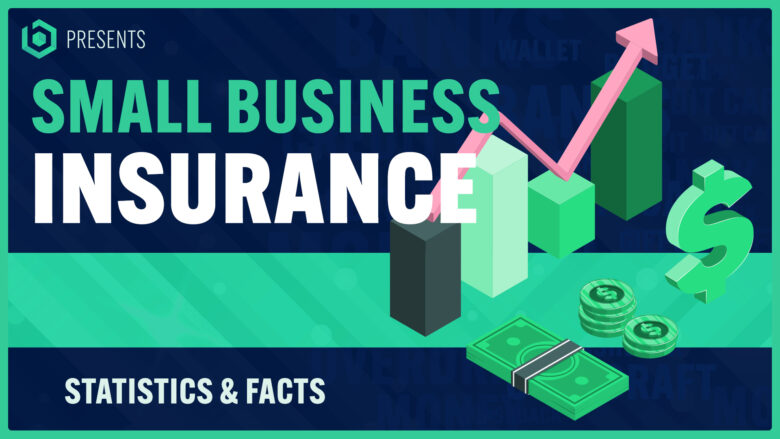Are you aware of how important insurance is for your small business? With a startling 40% of small businesses operating without any form of insurance, it’s clear that many underestimate its value.
This article breaks down the vital statistics and facts about small business insurance to help you understand its significance in safeguarding against unexpected risks and losses. Let’s take an enlightening journey into the world of small business insurance together.
- 40% of small businesses in the United States operate without any insurance, leaving them vulnerable to financial risks and potential losses.
- 75% of businesses in the US are underinsured, lacking sufficient coverage to protect against various risks and liabilities they may face.
- Burglary and theft account for 20% of all small business insurance claims, highlighting the importance of adequate coverage for these risks.
- Small businesses pay a total of $314 billion in insurance premiums, revealing the significant economic impact of small business insurance.
Key Small Business Insurance Statistics

Small business insurance statistics reveal that a staggering 40% of small business owners do not have any insurance coverage at all, leaving them vulnerable to financial risks and potential losses.
Additionally, nearly three-quarters (75%) of businesses in the United States are underinsured, lacking sufficient coverage to protect against various risks and liabilities they may face. This lack of adequate insurance puts small businesses at significant risk if an unexpected event or accident occurs, emphasizing the importance of understanding and securing appropriate insurance policies for their protection.
Percentage of Small Businesses Without Insurance
Surprisingly, 40% of small businesses in the United States operate without any insurance in place. This leaves vast swaths of the commercial landscape susceptible to financial losses from unexpected events or disasters.
From property damage due to fire or storms, employee injuries on the job, to customer claims for faulty products or services – these can all inflict significant cost burdens on uninsured companies.
It highlights a concerning level of risk being shouldered by small business owners who may underestimate the value and necessity of having adequate coverage to protect their establishments.
Average General Liability Costs for Small Businesses
In the world of small business insurance, general liability coverage plays a crucial role. For an average cost of just $42 per month or $500 annually, businesses gain protection from financial pitfalls that could otherwise bring operations to a halt.
Such costs are often outweighed by the security it provides in covering a myriad of risks such as client complaints, contract disputes, employee-related injuries and more.
Even so, it’s startling to learn that almost 40% of small business owners opt to operate without any form insurance at all. This lack of coverage leaves these businesses vulnerable to devastating financial losses stemming from unexpected risk events.
Coverage options like commercial auto insurance or property damage from fire can safeguard against various unforeseen circumstances related to both workplace incidents and external factors. Nevertheless, purchasing affordable general liability insurance should be viewed not as an expense but rather as a long-term investment for any successful small business venture.
Frequency and Nature of Claims Filed by Small Businesses
Small businesses face a myriad of risks daily, reflected in the frequency and nature of their insurance claims. A startling statistic reveals that over a decade, 40% of small firms will file an insurance claim.
This data underscores the significance of having adequate business insurance coverage. In dissecting the types of claims usually made by these enterprises, burglary and theft emerge as major concerns accounting for 20% of all small business claims submitted to insurers.
These statistics have heightened importance when considering that three-quarters of US businesses are underinsured – including those most vulnerable: businesses with only 3-9 employees which neglect to provide health insurance for their workers half the time or more often than not (52%).
Amidst evolving threats such as cyber attacks also growing in prevalence, it is clear that comprehensive understanding and awareness of risk events among small businesses can guide appropriate uptake of policies like general liability or commercial property insurances offered by reliable carriers in order to mitigate these potential pitfalls effectively.
33 Small Business Insurance Statistics

Here are the 33 interesting Small Business Insurance Statistics, ordered with the most compelling statistics at the top:
Here are the 33 interesting Small Business Insurance Statistics, randomized and reordered with the most compelling statistics at the top:
- 40% of small businesses are likely to experience a property or general liability claim in the next 10 years (Source: Insurance Information Institute).
- United States small businesses employed 58.9 million people, or 47.5% of the private workforce, in 2015 (Source: U.S. Small Business Administration).
- Small businesses created 1.9 million net jobs in 2015 (Source: U.S. Small Business Administration).
- The most common claims are burglary and theft, costing $8,000 per claim (Source: Insurance Information Institute).
- The number of small businesses in the Professional, Scientific, and Technical Services industry was 796,737 in 2015 (Source: U.S. Small Business Administration).
- A total of 294,834 companies exported goods from the United States in 2015. Of these, 287,835, or 97.6%, were small firms; they generated 32.9% of the United States’s $1.3 trillion in total exports (Source: U.S. Small Business Administration).
- The number of small businesses in the Construction industry was 668,196 in 2015 (Source: U.S. Small Business Administration).
- The top writer of commercial lines insurance by direct premiums written in 2022 was Chubb Ltd., with $24,488,270 (Source: Insurance Information Institute).
- There are over eight million small businesses in the U.S., ranging from construction firms to grocery stores to home-based businesses (Source: Insurance Information Institute).
- The median income for individuals self-employed at their own incorporated businesses was $50,347 in 2016 (Source: U.S. Small Business Administration).
- The number of banks decreased by 271 between June 2016 and June 2017 to 5,787 banks (Source: U.S. Small Business Administration).
- In 2016, 5.7 million loans under $100,000 (valued at $82.6 billion) were issued by United States lending institutions reporting under the Community Reinvestment Act (Source: U.S. Small Business Administration).
- The number of proprietors increased in 2016 by 2.3% relative to the previous year (Source: U.S. Small Business Administration).
- The smallest gains in net jobs were in firms employing 100 to 499 employees, which added 387,874 net jobs (Source: U.S. Small Business Administration).
- For individuals self-employed at their own unincorporated firms, the median income was $23,060 (Source: U.S. Small Business Administration).
- Wind and hail damage claims average about $26,000 (Source: Insurance Information Institute).
- Water and freezing damage claims average about $17,000 (Source: Insurance Information Institute).
- The average cost of a customer slip and fall claim is $20,000 (Source: Insurance Information Institute).
- Reputational harm claims cost an average of $50,000 (Source: Insurance Information Institute).
- Vehicle accident claims cost an average of $45,000 (Source: Insurance Information Institute).
- 35% of all general liability claims result in a lawsuit (Source: Insurance Information Institute).
- Professional liability insurance, also known as errors and omissions (E&O) insurance, covers a business against negligence claims due to harm that results from mistakes or failure to perform (Source: Entrepreneur).
- Property insurance is a must for businesses whether they own or lease their space. This insurance covers equipment, signage, inventory, and furniture in the event of a fire, storm, or theft (Source: Entrepreneur).
- Workers’ compensation insurance should be added to a business’s insurance policy once the first employee has been hired (Source: Entrepreneur).
- Many professionals begin their small businesses in their own homes. Unfortunately, homeowner’s policies don’t cover home-based businesses in the way commercial property insurance does (Source: Entrepreneur).
- If your business manufactures products for sale on the general market, product liability insurance is a must (Source: Entrepreneur).
- If company vehicles will be used, those vehicles should be fully insured to protect businesses against liability if an accident should occur (Source: Entrepreneur).
- Business interruption insurance compensates a business for its lost income during events like a disaster or catastrophic event (Source: Entrepreneur).
- Commercial insurance performs a critical role in the world economy. Without it, the economy could not function (Source: Insurance Information Institute).
- Incurred losses for commercial insurance increased from $137,939,624 in 2017 to $184,908,130 in 2021 (Source: Insurance Information Institute).
- In the third quarter of 2016, 240,000 establishments started up, generating 872,000 new jobs in the United States (Source: U.S. Small Business Administration).
- In the same period, 215,000 establishments exited resulting in 749,000 jobs lost (Source: U.S. Small Business Administration).
- Firms with fewer than 100 employees have the largest share of small business employment (Source: U.S. Small Business Administration).
A Closer Look at Specific Insurance Claims
Now let’s dive deeper into specific insurance claims that small businesses commonly face. From burglaries and thefts to property damage caused by fires, storms, or plumbing issues, we’ll explore the impact of these incidents on small businesses.
Read on to learn more about the importance of having adequate insurance coverage for your business.
Claims Related to Burglary and Theft
Burglary and theft are significant risks that small businesses often face, and it is reflected in small business insurance statistics. In fact, burglary and theft account for approximately 20% of all small business insurance claims.
These acts can have a devastating impact on businesses, leading to financial losses, disruptions in operations, and loss of valuable assets.
Small businesses may experience break-ins resulting in stolen equipment or merchandise or damage to property during the act of theft. Such incidents can cause extensive financial strain on already vulnerable enterprises.
The costs associated with replacing stolen items or repairing damaged property can quickly add up, affecting the bottom line of the business.
Business owners need to be aware of this risk and take precautions to protect their assets against burglary and theft. This includes implementing security measures such as surveillance systems, alarm systems, secure locks, and employee training on proper security protocols.
Additionally, having adequate insurance coverage specifically tailored to guard against burglary and theft is crucial for small businesses’ long-term sustainability.
Property Damage Claims Due to Fire, Storms, or Plumbing Issues
Small businesses often suffer property damage as a result of fire, storms, or plumbing issues. In fact, these types of claims account for 6.6% of all small business insurance claims. These unexpected incidents can cause significant financial setbacks and disrupt day-to-day operations.
For small business owners who may not have the resources to handle such damages on their own, having insurance coverage is crucial. Unfortunately, 40% of small and medium-sized enterprises (SMEs) currently have no business insurance at all, putting them at even greater risk of financial loss in the event of property damage.
It is essential that small businesses prioritize obtaining proper insurance coverage to protect themselves against unforeseen events that could potentially impact their livelihoods.
The Role of Cyber Insurance for Small Businesses

Small businesses are increasingly at risk of cyber attacks, yet only 31% have cyber insurance to protect themselves. Discover the importance of cyber insurance and how it can safeguard your business from costly data breaches and online threats.
Don’t leave your business vulnerable – read more about the role of cyber insurance for small businesses now.
Statistics on Small Business Cyber Insurance
The rise in cyber threats and data breaches has greatly elevated the importance of cyber insurance for small businesses. Cyber insurance provides a necessary safety net for small businesses, helping to offset the financial losses resulting from cyber incidents. Here’s a closer look at some statistics that highlight this growing trend.
| Statistic | Value |
|---|---|
| Percentage of small businesses with cyber insurance | 31% |
| Number of small businesses not buying insurance online | 76% |
| Vulnerability of small businesses to cyber attacks due to limited resources | High |
| Importance of cyber insurance in protecting small business operations | Increasing |
| Insurance recommendations for small businesses | Investing in cyber insurance via third-party providers and digital solutions |
| Role of cyber insurance | Covers expenses related to data breaches, network security failures, and ransomware attacks |
Insurer companies need to focus on building technical excellence by investing in advanced price and risk models and integrating with digital sales channels. By doing so, they can provide a seamless customer experience through both online and offline contact points, depending on customer preference.
The Economic Impact of Small Business Insurance
Small business insurance has a significant economic impact, with small businesses paying a total of $314 billion in insurance premiums and representing 7 million businesses that rely on commercial insurance to stay financially protected.
Gross Insurance Premiums Worldwide
The global insurance industry continues to demonstrate significant financial power, with its substantial contribution to the worldwide economy. Below is an HTML table that provides an overview of the gross insurance premiums across the globe.
| Location | Occupied Percentage | Gross Premiums (in trillion USD) |
|---|---|---|
| Global | 100% | 5.2 |
| US | Over 50% | Varies |
| All Other OECD Countries | Less than 50% | Varies |
In the grand scheme of things, the US market dominates the insurance industry, contributing more than half of the gross premiums for OECD members. These gross premiums represent a noteworthy portion of the GDP in these countries, with almost 10% in all OECD member countries. Consequently, the significance of the insurance industry and its economic impact cannot be overlooked.
Percentage of GDP for All OECD Countries
The insurance industry is a major player in the economies of the Organisation for Economic Co-operation and Development (OECD) member countries. In 2021, insurance premiums accounted for approximately 10% of the GDP in these countries, a significant increase from previous years. This trend is mainly driven by the high demand for all types of insurance, from personal lines to commercial coverage, such as small business insurance.
Here is a detailed breakdown of the percentage of GDP that insurance premiums represent in selected OECD countries:
| Country | Percentage of GDP |
|---|---|
| United States | 10% |
| United Kingdom | 9.1% |
| Germany | 6.8% |
| France | 9% |
| Canada | 7.8% |
| Japan | 11.2% |
In 2021, small businesses in the US alone paid a staggering $314 billion in insurance premiums, reflecting the critical role that insurance plays in safeguarding business operations and assets. It’s worth noting that these figures do not only represent the direct financial contribution of the insurance sector to the GDP but also symbolize the robustness and resilience of the overall economy.
Total Premiums in the US
In the United States, the total premiums for small business insurance reach a staggering amount of $314 billion. This demonstrates the enormous market size and the importance of insurance in the small business sector.
| Market Size | Total Premiums |
|---|---|
| Small Business Insurance in the US | $314 billion |
This signifies a vast opportunity for insurance providers and implies that small businesses are willing to invest heavily in securing their assets and operations. Despite these considerable premiums, 75% of businesses in the US are not adequately insured. Therefore, it becomes evident that there is still a considerable potential for growth in the industry. With the right insurance products and awareness campaigns, the market can tap into the unmet insurance needs of small businesses.
The Future of Small Business Insurance
The future of small business insurance holds great opportunities for growth and innovation. As the insurance landscape continues to evolve, there will be a rise in insurtechs and digital-sales capabilities, offering businesses more streamlined options for coverage.
Stay ahead of the curve by exploring the latest trends and advancements in small business insurance to protect your business from potential risks. Read on to discover how small business insurance can safeguard your operations and ensure long-term success.
Opportunities in the SME Insurance Sector
The SME insurance sector presents significant opportunities for growth and expansion. With 40% of small business owners currently without insurance coverage, there is a substantial market to tap into.
By offering tailored insurance solutions specifically designed for small and medium-sized enterprises, insurance companies can help address the needs of these businesses and provide them with the necessary protection.
Moreover, with only 31% of SMBs having cyber insurance, there is a clear opportunity to educate and offer cybersecurity policies that safeguard businesses against potential online threats. As the digital landscape continues to evolve, insurtech companies that have embraced digital sales capabilities are well-positioned to capitalize on this growing market segment.
Our Takeaway
In conclusion, the statistics on small business insurance paint a concerning picture. With 40% of small business owners lacking any insurance coverage and 75% being underinsured, it is evident that many businesses are at risk.
The need for increased awareness and prioritization of insurance coverage, especially in areas such as cyber insurance and property damage claims, cannot be overstated. Taking proactive measures to protect their livelihoods is crucial for small business owners in today’s unpredictable world.
Article Sources & Helpful Links
Here are some helpful links that may help you learn more:
- Insurance Information Institute: Small Business Facts and Statistics – A comprehensive resource for small business insurance statistics and facts.
- U.S. Small Business Administration: Get Business Insurance – Official guide on how to get business insurance, including types of insurance and steps to buy insurance.
- National Association of Insurance Commissioners – A regulatory support organization created and governed by the chief insurance regulators from the 50 states, the District of Columbia and five U.S. territories.
- International Risk Management Institute – Provides education, publications, and conferences for risk management and insurance professionals.
- California Department of Insurance – The official website of the California Department of Insurance, providing information on various types of insurance.
- Federal Emergency Management Agency (FEMA) – The official site of FEMA, providing resources and information on disaster management and insurance.
- Here are the sources used to compile the statistics:
- Insurance Information Institute: A leading source for insurance information, providing comprehensive data on the insurance industry.
- U.S. Small Business Administration: The U.S. Small Business Administration is the official site of the U.S. government that provides support to entrepreneurs and small businesses.
- Entrepreneur: Entrepreneur is a North American publication that carries news stories about entrepreneurialism, small business management, and business opportunities.
Small Business Insurance Statistics (FAQs)
What are small business insurance statistics?
Small business insurance statistics refer to data and information related to insurance coverage, claims, and other aspects of the insurance industry specifically pertaining to small businesses.
Why is it important for small business owners to have insurance?
Small business owners may face a wide range of challenges that can result in financial loss. Insurance can offer protection in case of property damage, liability claims, and other situations that could negatively impact a business’s finances.
What types of insurance should a small business owner have?
The appropriate insurance coverage for a small business will depend on factors such as industry, location, and size. However, some common types of insurance include general liability, property insurance, business interruption insurance, and workers’ compensation.
What is a premium?
A premium is the amount of money a policyholder pays to an insurance carrier in exchange for insurance coverage.
What is the process for filing a claim?
If a small business owner experiences an insurable event, such as property damage or a liability claim, they can file a claim with their insurance carrier. The carrier will then investigate the claim and determine whether it is covered by the policy and to what extent.
How can small business owners find the right insurance coverage?
Many small business owners work with insurance brokers or agents to help them assess their insurance needs and find appropriate coverage. They can also research insurance plans online and compare different policies to find the best fit for their business.
What are some common insurance stats for small businesses?
According to a survey conducted by a leading insurance carrier, in 2022, 64 percent of small business owners experienced an insurable event that led to an insurance claim. The same survey showed that liability claims were the most common type of claims for small businesses.
What is meant by a business insurance claim?
A business insurance claim refers to a situation in which a policyholder experiences an insurable event that results in financial loss and files a claim with their insurance carrier in order to receive compensation for the damages.
What is a carrier?
A carrier is an insurance company that provides coverage to policyholders in exchange for premiums.
How can small business owners balance increasing coverage with rising premiums?
Small business owners may need to assess the level of risk their business faces and consider how much coverage they actually need. They can also look for ways to reduce their risk, such as implementing safety measures or taking steps to prevent theft or burglary, which may result in fewer claims and lower premiums over time.




